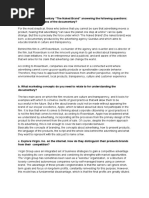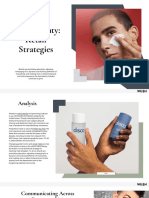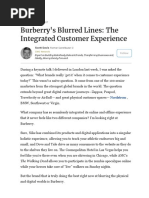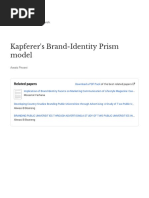Can A Brand Drastically Change Its Target Audience?: PS: The Marlboro Man Died of Real Lung Cancer
Can A Brand Drastically Change Its Target Audience?: PS: The Marlboro Man Died of Real Lung Cancer
Uploaded by
Saloni GinnareCopyright:
Available Formats
Can A Brand Drastically Change Its Target Audience?: PS: The Marlboro Man Died of Real Lung Cancer
Can A Brand Drastically Change Its Target Audience?: PS: The Marlboro Man Died of Real Lung Cancer
Uploaded by
Saloni GinnareOriginal Description:
Original Title
Copyright
Available Formats
Share this document
Did you find this document useful?
Is this content inappropriate?
Copyright:
Available Formats
Can A Brand Drastically Change Its Target Audience?: PS: The Marlboro Man Died of Real Lung Cancer
Can A Brand Drastically Change Its Target Audience?: PS: The Marlboro Man Died of Real Lung Cancer
Uploaded by
Saloni GinnareCopyright:
Available Formats
Can a brand drastically change its target audience?
In today’s digital age if a brand changes its gender specific target audience, the whole
messaging around the brand will change including the brand elements i.e. Brand
Association, Brand loyalty etc. Not to forget it will shoot up the work of the communication
team across all platforms.
Marlboro launched in 1924 and was targeted inly towards women, which was progressive
and digressive at the same time but that’s a topic for another day. Let’s talk about how they
smoothly repositioned themselves from a female centric brand to a male centric brand.
Their cigarettes were seen as feminine and the tag line was Mild and May. In the wake of
social awareness advertising, media started linking smoking to lung cancer and resulted in
cut down in cigarette consumption by women. Men also switched to Filter Cigarettes which
Philip Morris saw as an opportunity to rebrand the product as Marlboro was already selling
filter cigarettes.
That’s when Marlboro confined into Leo Burnett which came up with one of the most iconic
advertising hero “Marlboro Man”. Initially the campaign ran with construction workers,
Navy officers & mechanics but people found macho cowboy most relatable. This changed
the brand positioning completely, from a feminine brand it became a symbol of masculinity.
According to an article by ad age, the original ad by Burnett carried the slogan “delivers the
goods on flavor” and the sales went skyrocketing.
One thing to learn from this is that the brands should always be ready to adapt to changing
environments and customer needs. In Indian context also, Brand mascots can be very
powerful to attain brand awareness for instance how Amul has still has the Amul Girl in all
their topical ads.
PS: The Marlboro man died of real lung cancer.
You might also like
- Emotional Branding: The New Paradigm for Connecting Brands to PeopleFrom EverandEmotional Branding: The New Paradigm for Connecting Brands to PeopleRating: 4 out of 5 stars4/5 (13)
- Sales and Distribution Project - MarlboroDocument12 pagesSales and Distribution Project - MarlboroShreya JainNo ratings yet
- MarlboroDocument3 pagesMarlboroAhmer TareenNo ratings yet
- Marketing Strageties Marlboro CigarettesDocument9 pagesMarketing Strageties Marlboro Cigarettesapi-254567395No ratings yet
- Marketing Strageties Marlboro CigarettesDocument9 pagesMarketing Strageties Marlboro Cigarettesapi-254638109No ratings yet
- Lifestyle MarketingDocument2 pagesLifestyle MarketingYashaswi GuptaNo ratings yet
- Sex Change of A Brand-Story of MarlboroDocument9 pagesSex Change of A Brand-Story of MarlboroKrishnamurthy Prabhakar100% (45)
- The Marlboro ManDocument10 pagesThe Marlboro Manapostolescuadrian0No ratings yet
- Marlboro Man Case StudyDocument3 pagesMarlboro Man Case StudyNgân LêNo ratings yet
- Marlboro CaseDocument10 pagesMarlboro CaseZooNo ratings yet
- Repositioning Success of Marlboro: Akshay Srivastava Roll No. 55Document12 pagesRepositioning Success of Marlboro: Akshay Srivastava Roll No. 55Akshay SrivastavaNo ratings yet
- Hành VI Khách Hàng - BT3Document6 pagesHành VI Khách Hàng - BT3Việt Thi OfficialNo ratings yet
- The History of Mariboro: Source: Http://Industrydocuments - Library.Ucsf - Edu/Tobacco/Docs/Rhcp0124Document8 pagesThe History of Mariboro: Source: Http://Industrydocuments - Library.Ucsf - Edu/Tobacco/Docs/Rhcp0124Aaam BertNo ratings yet
- Marlboro Story Case BriefDocument26 pagesMarlboro Story Case BriefManuj GirdharNo ratings yet
- Marketing ToolDocument6 pagesMarketing Toolanon_270604298No ratings yet
- Top 10 Advertising Icons of The CenturyDocument7 pagesTop 10 Advertising Icons of The CenturyZirseyNo ratings yet
- Case Studyedited MarlboroDocument4 pagesCase Studyedited MarlboroHemanth KittuNo ratings yet
- Brand Management Case Study ONDocument9 pagesBrand Management Case Study ONSabshNo ratings yet
- The Cowboy From Marlboro Country Is Perceived by People As American Version of ExplorerDocument5 pagesThe Cowboy From Marlboro Country Is Perceived by People As American Version of ExplorerRohit BholaNo ratings yet
- Global Iconic Brand - Marlboro PankajDocument30 pagesGlobal Iconic Brand - Marlboro PankajTushar PattanashettiNo ratings yet
- Aman Pava AssignmentDocument4 pagesAman Pava AssignmentDhawal JainNo ratings yet
- The Brand Element Model For MarlboroDocument6 pagesThe Brand Element Model For MarlboroRahul JainNo ratings yet
- Marlboro FDocument21 pagesMarlboro Fmusadhiq_yavar100% (1)
- The Origin and Genesis of The Marlboro Brand: Brief HistoryDocument4 pagesThe Origin and Genesis of The Marlboro Brand: Brief Historytech& GamingNo ratings yet
- Branding Handout - UpdatedDocument31 pagesBranding Handout - UpdatedIBA PrepworksNo ratings yet
- Report of Qualitative Research StudyDocument41 pagesReport of Qualitative Research StudyKhawar AzizNo ratings yet
- Marlboro SwotDocument5 pagesMarlboro SwotAnurag GuptaNo ratings yet
- Sales-Distribution-Report MARLBORO Cigerete 1Document64 pagesSales-Distribution-Report MARLBORO Cigerete 1Md. ShakirNo ratings yet
- The Marlboro ManDocument3 pagesThe Marlboro ManhirukihasithmaNo ratings yet
- History of BrandingDocument33 pagesHistory of BrandingSamra SiddiquiNo ratings yet
- Marlboro Man 2Document11 pagesMarlboro Man 2tarangbahetiNo ratings yet
- Liril Case - 1Document13 pagesLiril Case - 1Vishal Jagetia100% (3)
- Brand Mgt. Case 1 & 2Document7 pagesBrand Mgt. Case 1 & 2Prashant TomarNo ratings yet
- 26 Classic Branding Success StoriesDocument30 pages26 Classic Branding Success StoriesCh. KashifNo ratings yet
- Burberry and GucciDocument5 pagesBurberry and GucciShefali PatelNo ratings yet
- Brand Identity PrismDocument2 pagesBrand Identity PrismDAS RUMPA0% (1)
- MGT176 - Marlboro Distribution SystemDocument16 pagesMGT176 - Marlboro Distribution SystemErfan TanhaeiNo ratings yet
- Corporatives Brands Uni Norte 8-02-21Document5 pagesCorporatives Brands Uni Norte 8-02-21Adriana MartinezNo ratings yet
- Group 6A BurberryDocument1 pageGroup 6A BurberrynnischalNo ratings yet
- Icons Are Inclusive: Iconic BrandsDocument8 pagesIcons Are Inclusive: Iconic BrandsSwati RathoreNo ratings yet
- Bonus Optional Write-Up #1: FORE School of ManagementDocument5 pagesBonus Optional Write-Up #1: FORE School of ManagementAshish AroraNo ratings yet
- Summary of The Burberry CaseDocument2 pagesSummary of The Burberry CaseSumit JajuNo ratings yet
- Brut Sales Promotion PlanDocument13 pagesBrut Sales Promotion PlanEmily FullerNo ratings yet
- RED BULL AssignmentDocument1 pageRED BULL Assignmentkopy brayntNo ratings yet
- Men S Beauty Retail Strategies PDFDocument10 pagesMen S Beauty Retail Strategies PDFGustavo Dos Santos AngeliNo ratings yet
- Marlboro BrandingDocument11 pagesMarlboro BrandingSURYA TEJA DASARINo ratings yet
- Burberry's Blurred Lines - The Integrated Customer ExperienceDocument6 pagesBurberry's Blurred Lines - The Integrated Customer ExperienceREAZ HasanNo ratings yet
- Cheat On Your Girlfriend Not On Your WorkoutDocument3 pagesCheat On Your Girlfriend Not On Your WorkoutElias Cherem MustriNo ratings yet
- The History of BrandingDocument9 pagesThe History of BrandingArtcore StudioNo ratings yet
- What Is Branding, Anyway?: Chapter OneDocument15 pagesWhat Is Branding, Anyway?: Chapter OnePardeep KumarNo ratings yet
- Images of Modern MenDocument1 pageImages of Modern MenamhammondNo ratings yet
- A Degree in a Book: Marketing: Everything You Need to Know to Master the Subject - in One Book!From EverandA Degree in a Book: Marketing: Everything You Need to Know to Master the Subject - in One Book!No ratings yet
- 4 Personalbranding Akbar Issue1vol1Document9 pages4 Personalbranding Akbar Issue1vol1Ella ZărnescuNo ratings yet
- Philip MorrisDocument8 pagesPhilip MorrisfelixesNo ratings yet
- Pooja Anil Hemdev: Marlboro - A Mini Case StudyDocument25 pagesPooja Anil Hemdev: Marlboro - A Mini Case StudyIvanBučevićNo ratings yet
- АберкромбиDocument4 pagesАберкромбиAnya VilardoNo ratings yet
- FBM BIP V - Het - Brand-Identity - Prism - Model - Van - Kapferer - EN - PDFDocument3 pagesFBM BIP V - Het - Brand-Identity - Prism - Model - Van - Kapferer - EN - PDFKomal AroraNo ratings yet
- Brand-Identity Prism Model Van Kapferer EN - With-Cover-Page-V2Document4 pagesBrand-Identity Prism Model Van Kapferer EN - With-Cover-Page-V2Lalit YedgeNo ratings yet
- Creating a Powerful Brand: It's Not Just Business, It's PersonalFrom EverandCreating a Powerful Brand: It's Not Just Business, It's PersonalNo ratings yet



























































